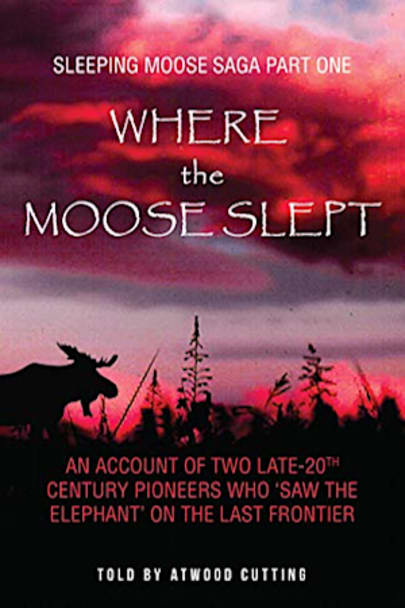The setting is deep in a field of wildflowers, far from any city. It is during the Alaska oil boom, and two anachronistic romantics have heeded the call of the wild, and journeyed to meet their life’s adventure in the far north. Kate, the poet, has come from Hawaii to Alaska, ‘to see a winter.’ Inspired by the pervading idealism of the sixties, she dreams of establishing a harmonious world. Tim, … Tim, a soldier returning from Vietnam, simply wants to build a log home and live life the way he wishes, like Jeremiah Johnson. They meet in Fairbanks, elope, and set about making their dream real. Call it “Idealism meets Reality.” After a decade of travail, in part three of the Sleeping Moose Saga, the outcome of their wilderness experiment echoes “seeing the elephant” described by many of the mid-19th century covered wagon migrants who traveled west. It is not the well-deserved victory imagined by daring pioneers who leave their homes in search of something greater, but whether to wallow or to revel is a choice that lies within each of us.
Classification: Teen and Young Adult Historical Fiction
Recreational reading: Action, Adventure, Nature
Curriculum-related use and reference for studies in:
American Literature
Transcendentalism
Emerson, and self-reliance
Creative Writing
Nonfiction narrative
Alaska bush life adventures
Memoirs of women
Bildungsroman
Women’s Studies
Letters and journals of a pioneer wife
Frontier Women
History of American Pioneering
Folklore ‘Seeing the Elephant’
more



Why This Book
I met a wonderful blogger about three months ago who I began exchanging emails with each week, chatting about books, life, and many other topics. After a while, she casually mentioned her book, which of course led me to reading a little more about it and her. I recently started a new segment on my blog called ‘Author Alert,’ where new authors can share a message with my friends and followers – Atwood Cutting, author of Where the Moose Slept: An Account of Two Late-20th Century Pioneers Who “Saw the Elephant” on the Last Frontier, is today’s (Fri 12/15) latest author. But first I had to finish reading her book this week and write this review…
Approach & Style
I read this ~300 page book via Kindle Reader on my iPad in 4 hours over three days. It is a cross between fiction and non-fiction, as it is a true account, almost a journal, of a woman and her family’s experiences; however, a few things were changed around in how the story was told so that it reads more like a story. Atwood tells accounts of her life through letters home to her mother, in episodes focused on their trek around Alaska, and via pictures from the entire time period.
Plot, Characters & Setting
Kate and Tim Peters were recently married, making the trek up to Alaska for the oil boom during the mid-1970s, several years after college. Picture frontier life in a more modern world (still didn’t have electricity in the beginning, tho!) and learning how to adapt to life in the wilderness where animals — and people — attack. Through building a home, getting to know their neighbors, learning how to adapt to married life, finding ways to earn money and survive, they meet some potentially life-long friends (I only read the first book… not sure of the ending even though I know and chat with the author) in this beautiful backdrop where the moose sleep – in search of seeing the elephant (you’ll have to read the book to know what that means).
Key Thoughts
Atwood’s voice is the best part of the book. Writing an account of your life, understanding what to include about the mundane versus existing parts of your life, is critical. Through the characters, Kate and Tim, she achieves a charismatic and earthy combination of humanity. Life for many of us who live in a city or the suburbs seems difficult, but you don’t know difficult until you truly rough it on land that’s never been lived on before. Seeing (the pictures are fantastic) and reading about their lives gives you a bit of the goosebumps, worried for their safety and mental health. It can be lonely and cold; it can be dangerous and boring. But through trust and a strong relationships, two people can achieve a lot of success — success which is measured differently when you go through a non-traditional path (building your own house in frigid temperatures with practically no neighbors around in a place you’ve never been and no knowledge of how to make it all work!), but in the end, you still experience that wonderful amazement of knowing you did it all with your own two hands.
This is the kind of book you want to read when you are bored with mysteries or general fiction, when you need something inspirational without being pedantic. It’s a light yet heavy account of a really different side of life, one we should all experience for ourselves at some point. But if you’re not the kind of person who will rush off to Siberia or Alaska, then dive into this book for an intense picture of what it might be like. You’ll enjoy some of the sentimental moments and many humorous conversations between Kate and Tim. I won’t spoil them here, so go read it.
Summary
I’m normally a fiction reader, who will throw in 5 to 10 non-fiction books each year. When I do, they’re usually based on a famous figure in history or a remarkable informational piece. When I chose Atwood’s book, I knew it would be a different kind of read because it was a personal journey with an incredibly charming voice — that alone makes it worth the read. But once I started it, the story became so much more. I look forward to reading more from this author and will keep on chatting with her to see how everything turns out in her life.